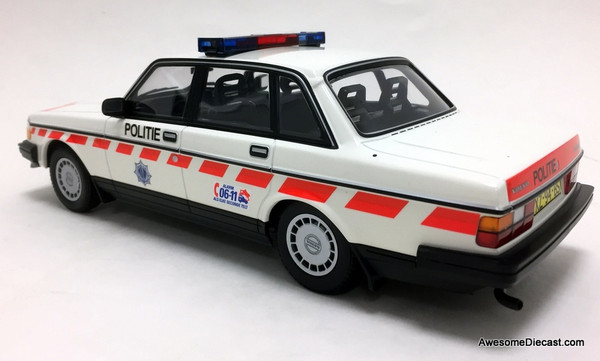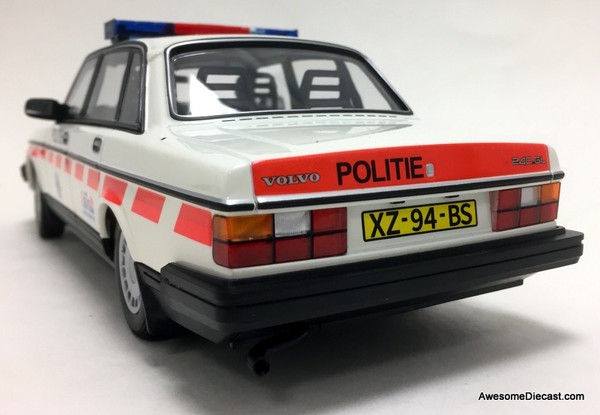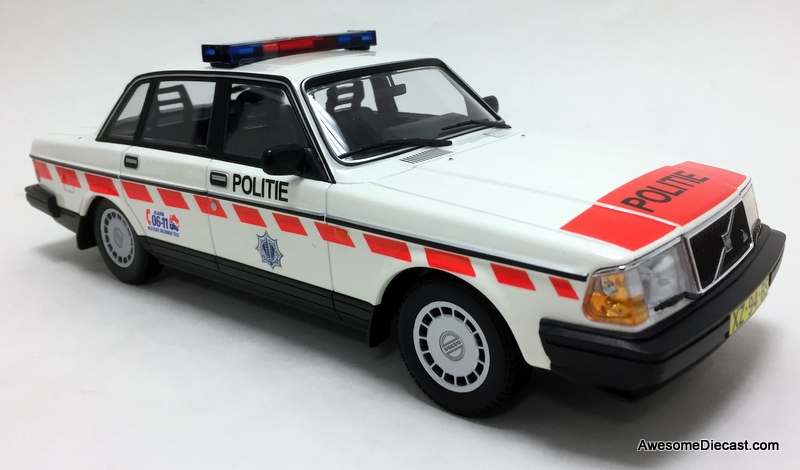This is a highly detailed limited edition resin model and is 1 of only 300 pieces worldwide
The antennas for the rear fenders are in the box
The Volvo 200 Series (or 240 and 260 Series) is a range of mid-size cars produced by Swedish company Volvo Cars from 1974 to 1993, with more than 2.8 million total units sold worldwide. Like the Volvo 140 Series (1966 to 1974), from which it was developed, it was designed by Jan Wilsgaard.
The series overlapped production of the Volvo 700 Series (1982 to 1992). As the 240 Series remained popular, only the 260 Series was displaced by the 700 Series, which Volvo marketed alongside the 240 for another decade. The 700 was replaced by the 900 Series in 1992, a year before the 240 was discontinued. Production of the 240 ended on 14 May 1993, after nearly 20 years.
The Volvo 240 and 260 series were introduced in the autumn of 1974, and was initially available as seven variations of the 240 Series (242L, 242DL, 242GT, 244DL, 244GL, 245L and 245DL) and two variations of the 260 Series (264DL and 264GL). The 240 Series was available in sedan (with two or four doors) or station wagon, however the 260 Series was available as a coupé (262C Bertone), four-door sedan, or station wagon. The 200 looked much like the earlier 140 and 164, for they shared the same body shell and were largely the same from the cowl rearward. However, the 200 incorporated many of the features and design elements tried in the Volvo VESC ESV in 1972, which was a prototype experiment in car safety. The overall safety of the driver and passengers in the event of a crash was greatly improved with very large front and rear end crumple zones. Another main change was to the engines, which were now of an overhead cam design. The 260 series also received a V6 engine in lieu of the 164's inline-six.
The 200 Series had MacPherson strut-type front suspension, which increased room around the engine bay, while the rear suspension was a modified version of that fitted to the 140 Series. The steering was greatly improved with the installation of rack-and-pinion steering, with power steering fitted as standard to the 244GL, 264DL and 264GL, and there were some modifications made to the braking system (in particular the master cylinder).
The front end of the car was also completely restyled with a "shovel nose" which closely resembled that of the ESV prototype vehicle – that being the most obvious change which made the 200 Series distinguishable from the earlier 140 and 160 Series. Other than all the changes mentioned above, the 200 Series was almost identical to the 140 and 160 Series from the bulkhead to the very rear end. In 1978, a facelift meant a redesigned rear end for sedans, with wraparound taillights and a trunk opening with a lower lip. The dashboard was derived from the safety fascia introduced for the 1973 model year 100 Series - the main change for the 200 Series was the adoption of slatted "egg crate" style air vents in place of the eyeball style vents used in the 140/160 and the square clock. All models were available with a choice of four-speed manual or a three-speed automatic transmission. Overdrive was also optional on the manual 244GL, while a five-speed manual gearbox was optional on the 264GL and 265GL.
In the autumn of 1975 (for the 1976 model year in America), the 265 DL estate became available alongside the existing range, and this was the first production Volvo estate to be powered by a six-cylinder engine. The choice of gearboxes was also improved, with overdrive now available as an option in all manual models except the base-model 242L and 245L. As before, a three-speed automatic was optional in every model. The B21A engine gained three horsepower; a new steering wheel and gearknob were also introduced.
For the 1983 model year, Volvo dropped the DL and GLE labels, selling the cars simply as 240s. In the domestic Swedish market the 240 could be had with a 2.1 or 2.3-liter engine (more options were available in export), but the bigger engine always came coupled with a five-speed transmission and tinted windows. The 1983s also received wider side trim and all models had the larger taillights introduced on the previous year's GLT model. A B23E-engined GLE variant was also added (not available with two doors). Buyers protested against the lack of grades and they returned for 1984. A new manual gearbox also arrived for 1984, while a four-speed automatic option was available in the GL. The GLT and Turbo versions received a taller grille.
About one-third of all 240s sold were station wagons, which featured very large cargo space of 41 cubic feet (1.2 m3). They could be outfitted with a rear-facing foldable jumpseat in the passenger area, making the wagon a seven-passenger vehicle. The jumpseat came with three-point seat belts, and wagons were designed to have a reinforced floor section, protecting the occupants of the jumpseat in the event of a rear-end collision.
The last 200 produced was a blue station wagon built to the Italian specification and named the "Polar Italia", currently displayed at the Volvo World Museum.

















